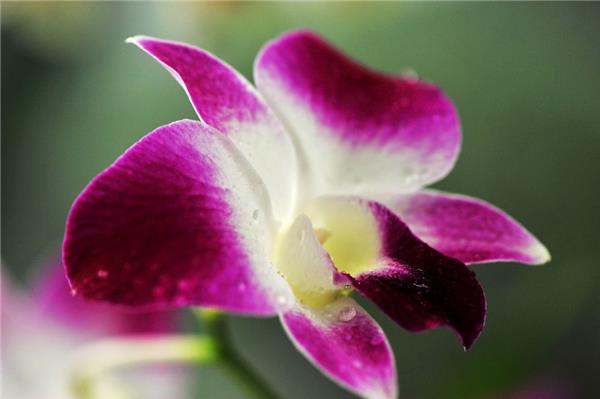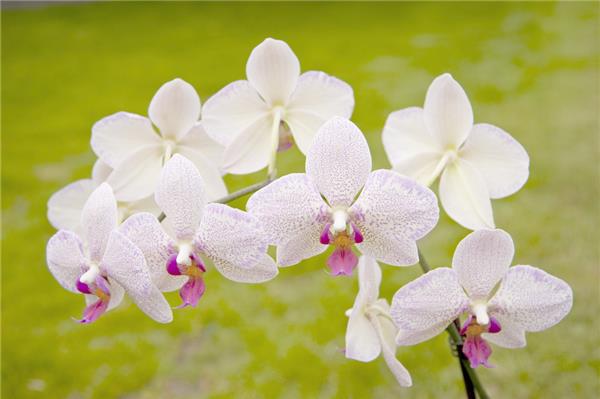Daily precautions in Orchid planting
Because the orchid is expensive as a "gentleman in the flower", so it is really like a gentleman to have a kind of fairy spirit of dust at that time, and it is natural to raise it very carefully and politely.

Soil selection: black hill mud, peat soil, pastoral soil, pine soil, moss fresh, fern root, bark block and so on can be used to grow orchids. The bottom of the basin is covered with tiles, then covered with a layer of broken brick and stone, with a thickness of 1/4 of the depth of the basin to enhance air permeability and drainage, and then spread a layer of culture soil. Plant the orchid, fill the culture soil, and cover the bulb. The soil should be compacted, and the soil should not be filled 2 meters away from Yikou, which is easy to water. After planting, pour enough water and place it in a cool shade. Half a month later, it was moved to a sunny and ventilated environment. In order to increase beauty and moisturizing power, the basin can be covered with a layer of small broken white stone.
Lighting: orchids like quiet and quiet, so when choosing places for orchid farming, try to choose places that will not be exposed to the sun. Orchids are generally placed in the open field in spring, summer and autumn, and indoors in winter. It is best to be open and moist outside. There should be plenty of light in the room, preferably facing south. In this way, it is beneficial for orchids to grow. The orchid basin had better be put on the wooden frame or table, not on the ground. Orchids are mostly semi-negative plants, and most species are afraid of direct sunlight and need proper shade. Orchids can shine more sunshine to promote their growth in the first and middle of April. It should be properly shaded after late April. The varieties of erect leaves in Xialan and Qiulan had better be placed in the south of the shade so that they are properly exposed to more sunlight, while those with vertical leaves are better exposed to two hours of light every day. From June to September, you should cover the shade early every day. If you use Reed curtains, you can use dense curtains or two thin curtains. After October, the weather turns cool and the sun is weak, which can postpone shading, but we still need to pay attention to shading around noon.

Water and fertilizer: orchids can be caught in light rain, but to avoid mildew, showers or continuous rain. The flower proverb says, "dry orchid and wet chrysanthemum", which has a certain degree of truth. Generally speaking, it is best for orchids to be eight minutes dry and two parts wet. Fat should be thin and thick: in the growing period. Pour the rotten bean cake water and horseshoe sauce residue water once every semimonthly. The effect is better if an appropriate amount of potassium dihydrogen phosphate is added. No fertilizer is applied in hot summer.
Change the basin and trim:
1. The time of changing the orchid pot is usually two years, and changing the pot too frequently will affect the growth of the orchid. If the pot is not changed for too long, the nutrients in the basin are almost consumed, and the orchid plants are numerous, the root system is too dense, the new root has no room to stretch, and the death, empty and old root remains in the basin. It may infect germs.
two。 Normally growing orchids can be changed throughout the year (except for extreme heat and cold). Most orchids change pots in spring and autumn. It is usually from late February to late April in spring and from late September to mid-November in autumn. But what must be done is that two days before changing the basin, watering should be controlled to make the basin a little drier, which is not only easy to take off the basin, but also can avoid breaking because of heavy water content in the orchid root.
3. The roots and leaves of the orchid should be trimmed before changing the basin, because the water of the orchid leaves will be lost when the sun shines on the orchid leaves, and it is necessary to replenish the water from the roots. Therefore, when changing the basin, it is necessary to observe the proportion of the orchid leaves and roots and do a proper trimming. Only in this way can the water loss and replenishment of the orchids tend to be balanced, and the growth of the orchids will be normal. Of course, the principle of trimming is to remove the bad ones and leave the good and useful parts. If all the roots under the old man are cut off, all the leaves above the old man will be pulled out, so that the old man's nutrients will be transferred to the new buds.

Disease and pest protection: orchids are easy to produce shell insects, which can be sprayed with dichlorvos EC 1000. When whitefly is damaged, it should be sprayed with 2000 times solution of deltamethrin. Langen has a sweet taste and is easy to attract ants, which can be killed by meat bones. Orchids are prone to anthracnose and black spot. After the occurrence of the disease, the burning of the diseased leaves should be removed in time, and the distance between the pot plants should be opened to improve the ventilation and light transmission conditions. Reduce water spraying and control humidity. And combined with carbendazim for control. Sterilization treatment (exposure in the hot sun) should be carried out to prevent the occurrence of diseases.

Florists still have to be flexible.
Related
- Wuhan Hospital Iron Tree Blooming Result Was Instantly Frightened by the Gardener Master
- Which variety of camellia is the most fragrant and best? Which one do you like best?
- What is the small blue coat, the breeding methods and matters needing attention of the succulent plant
- Dormancy time and maintenance management of succulent plants during dormancy
- Minas succulent how to raise, Minas succulent plant pictures
- What are the varieties of winter succulent plants
- How to raise succulent plants in twelve rolls? let's take a look at some experience of breeding twelve rolls.
- Attention should be paid to water control for succulent plants during dormant period (winter and summer)
- Watering experience of twelve rolls of succulent plants
- Techniques for fertilizing succulent plants. An article will let you know how to fertilize succulent plants.



